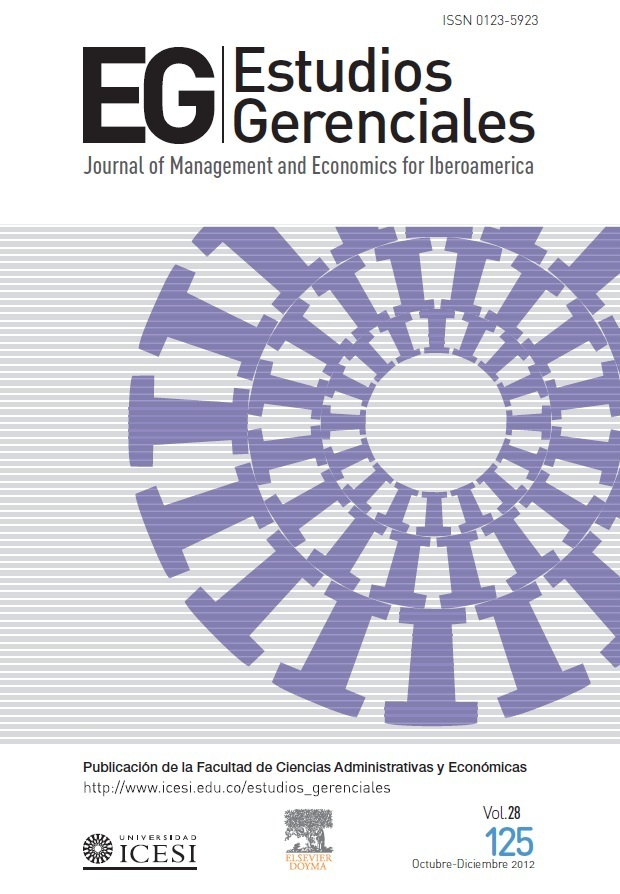Service quality perceptions in higher education institutions: the case of a colombian university
DOI:
https://doi.org/10.1016/S0123-5923(12)70004-9Palabras clave:
Higher education, Student satisfaction, Service quality, Quality factorsResumen
Recognizing that higher education institutions (HEI) are currently competing aggressively through competitive advantages and high service quality, the assessment of the service quality is essential to provide information on the effectiveness of educational plans and improvement programs. This article presents a study which tests the 5Q’s model proposed by Zineldin (2007), and examines the service quality factors
that most impact on student satisfaction. Factor analysis and regression analysis showed significant variables in explaining student satisfaction as: trust developed toward the university and the academic program, and the perception they have of assessment techniques as a challenge to improve intellectual growth
Descargas
Referencias
Berger, J. and Milem, J. (1999). The Role of Student Involvement and Perceptions of Integration in a Causal Model of Student Persistence. Research in Higher Education, 40, 641-664.
Brenders, D., Hope P. and Ninnan, A. (1999). A Systemic Student-Centered Study of University Service. Research in Higher Education, 40, 665-685.
Brown, R. and Mazzarol, T. (2009). The Importance of Institutional Image to Student Satisfaction and Loyalty within Higher Education. Higher Education, 58, 81-95.
Cook, M. (1997). A Student's Perspective of Service Quality in Education. Total Quality Management, 8, 120-125.
Cronin, J. and Taylor, S. (1992). Measuring Service Quality: A Reexamination and Extension. Journal of Marketing, 56, 55-68.
Darlaston-Jones, D., Pike, L., Cohen, L., Young, A., Haunold, S. and Drew, N. (2003). Are They Being Served? Students' Expectations of Higher Education. Issues in Educational Research, 13, 31-52.
Demaris, M. and Kritsonis, W. (2008). The Classroom: Exploring its Effects on Persistence and Satisfaction. Focus on Colleges, Universities and Schools, 2, 1-9.
Harvey, L. (2001). Student Feedback: A Report to the Higher Education Funding Council for England. Research report, Centre for Research into Quality, The University of Central England, Birmingham, United Kingdom.
Hayes, T. (2007). Delphi Study of the Future of Marketing of Higher Education. Journal of Business Research, 60, 927-931.
Hennig-Thurau, T., Langer, M. and Hansen, U. (2001). Modeling and Managing Student Loyalty: An Approach Based on the Concept of Relationship Quality. Journal of Service Research, 3, 331-344.
Hill,F.(1995). Managing Service Quality in Higher Education: The Role of the Student as Primary Consumer. Quality Assurance in Education, 3, 10-21.
Jurkowitsch, S., Vignali, C. and Kaufmann, H. (2006). A Student Satisfaction Model for Austrian Higher Education Providers Considering Aspects of Marketing Communications. Innovative Marketing, 3 (Special Edition), 9-23.
Lee, J. and Tai, S. (2008). Critical Factors Affecting Customer Satisfaction and Higher Education in Kazakhstan. International Journal of Management in Education, 2, 46-59.
Lounsbury, J.W., Saudargas,R.A., Gibson, L.W. y Leong, F.T. (2005). An investigation of broad and narrow personality traits in relation to general and domain-specific life satisfaction of college students. Research in Higher Education, 46(6).
Mishra, S. (2007). Quality Assurance in Higher Education: an Introduction (first edition). Bangalore: National Assessment and Accreditation Council (NAAC). Mostafa, M. M. (2007). A Comparison of SERVQUAL and I-P Analysis: Measuring and Improving Service Quality in Egyptian Private Universities. Journal of Marketing for Higher Education, 16, 83 -104.
Oliveira, O. and Ferreira, E.(2009). Adaptation and application of the SERVQUAL scale in higher education. Paper presented at the 20th Annual Conference of the Production and Operations Management Society (POM), Orlando, Florida. Available at: http://coba.georgiasouthern.edu/hanna/FullPapers/011-0072.pdf
Owlia, M. and Aspinwall, E. (1996). A Framework for the Dimensions of Quality in Higher Education. Quality Assurance in Education, 4, 12-20.
Pichardo, M., García, A., De la Fuente, J. and Justicia, F. (2007). El Estudio de las Expectativas en la Universidad: Análisis de Trabajos Empíricos y Futuras Líneas de Investigación. Revista Electrónica de Investigación Educativa, 9, 1-16.
Parasuraman A., Zeithaml, V. and Berry, L. (1985). A Conceptual Model of Service Quality and its Implications for Future Research. Journal of Marketing, 49, 41-50.
Parasuraman A., Zeithaml, V. and Berry, L. (1988). SERVQUAL: A Multiple-Item Scale for Measuring Consumer Perceptions of Services Quality. Journal of Retailing, 64, 12-40.
Parasuraman A., Zeithaml, V. and Berry, L. (1994). Reassessment of Expectations as a Comparison Standard in Measuring Service Quality: Implications for Further Research. Journal of Marketing, 58, 111-124.
Postema, M. and Markham, S. (2002). Student Satisfaction: A Method for Exploring Quality Factors within Computer Education. New Zealand Journal of Applied Computing and Information Technology, 6, 51-59.
Tan, K.and Kek, S.(2004). Service Quality in Higher Education Using an Enhanced SERVQUAL Approach. Quality in Higher Education, 10, 17-24.
Walter, S. (2006). Antecedentes da Satisfação e da Lealtade de Alunos de uma Institução de Ensino Superior. Master dissertation, Business Administration Department. Universidade Regional de Blumenau, Brasil.
Wright, R. (1996). Quality Factors in Higher Education: The Students' Viewpoint. College Student Journal, 30, 269-273.
Yeo, R. (2009). Service Quality Ideals in a Competitive Tertiary Environment. International Journal of Educational Research, 48, 62-76.
Zeithaml, V., Berry, L. and Parasuraman, A. (1996). The Behavioral Consequences of Service Quality, Journal of Marketing, 60, 31-46.
Zineldin, M. (2006). The royalty of loyalty: CRM, Quality and Retention. Journal of Consumer Marketing, 23, 430-437.
Zineldin, M. (2007). The Quality of Higher Education and Student Satisfaction Self assessment and Review process A TRM Philosophy and 5Qs Model. Paper presented at Second International Conference Education, Economics, and Law: Traditions and Innovations. Växjö University, Sweden. Available at: http://tempus.ulim.md/proj_dis.php.
Publicado
Número
Sección
Licencia
Los autores de artículos serán responsables de los mismos, y por tal no comprometen los principios o políticas de la Universidad Icesi ni las del Comité Editorial de la revista Estudios Gerenciales. Los autores autorizan y aceptan la cesión de todos los derechos a la revista Estudios Gerenciales, tanto en su publicación impresa como electrónica. Luego de publicado el artículo, puede ser reproducido sin autorización, mencionando autor(es), título, año, volumen, número y rango de páginas de la publicación, y como fuente: Estudios Gerenciales (abstenerse de usar Revista Estudios Gerenciales).








